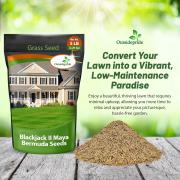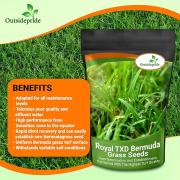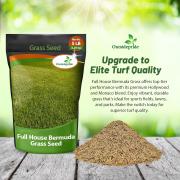
Fertilizing Bermuda Grass is one of the most satisfying lawn activities. Within a matter of days, a fertilized lawn will turn dark green and look healthy. Bermuda Grass lawns have one of the highest fertilizer requirements of any southern lawn grass. It grows best with a steady, consistent amount of fertilizer supplied throughout the growing season. If you apply more than the recommended amount, your lawn will not be any darker green, it will only grow faster and you will have to mow more often. The most efficient way to fertilize is to use one of the dry granular fertilizers that are sold in 10-50 lb bags. Hose end liquid fertilizers work, but they are difficult to use correctly and you will need to fertilize twice as often as with granular fertilizer.
Type of Fertilizer to use on Bermuda Grass
Fertilizer is described by the percentages of nitrogen (N), phosphorus (P), potassium (K) contained in the bag. All fertilizer bags are clearly labeled with these three numbers known as N-P-K ratio. Whenever possible use a slow release fertilizer with a 3-1-2 ratio. An example would be 12-4-8. A bag of 12-4-8 fertilizer contains 12% nitrogen, 4% phosphorus, and 8% potassium by weight. The remaining 76% is inert material that adds bulk to the mixture and makes it easier to spread.
It is important to use slow release fertilizers whenever possible. Most major brands of lawn fertilizer will have a combination of soluble and slow release forms of nitrogen (indicated on the label). Soluble nitrogen is available to the Bermuda Grass plant immediately while slow release nitrogen becomes available over a period of two to three months. In most situations it is best to have as much of the nitrogen in slow release form . This is usually noted in a statement like "containing 6% in slow release form."
Be careful when using hose end fertilizer sprayers or dry fertilizer in which all the nitrogen is in a soluble nitrogen will cause a major flush of growth for a week or two and will completely dissipate in 4-6 weeks. For most of us, it is almost impossible to fertilizer with quick release fertilizers without causing wild, fluctuating growth spurts. If you decide to use quick release fertilizer, never apply more than 1 pound of actual nitrogen per 1000 square feet. You will need to fertilize every 4-6 weeks during the growing season for a total of 4 or 5 applications. Stay on schedule throughout the season so that nitrogen levels will remain fairly constant in the soil.
How much Fertilizer to apply on Bermuda Grass
There are universal ways to know how much fertilizer to apply, regardless of the brand or the specific N-P-K ratio. All you need to do is figure out how much "actual nitrogen" is contained in the bag. Bermuda grass lawns generally need 4-5 pounds of actual nitrogen per 1000 square feet each year, regardless of the brand of fertilizer you purchase. If you use a fertilizer that contains a slow release form of nitrogen, you can apply the need nitrogen in three applications of 1.5 pounds of actual nitrogen per 1000 square feet in mid-spring, mid-summer and early fall.
Unfortunately, the average bag of fertilizer does not tell you how much actual nitrogen it contains in the bag, it is easy to calculate, though, using two simple pieces of information: the N-P-K ratio and the weight of the bag. Multiply the percentage of nitrogen (the first number of the N-P-K) by the weight of the bag and you will know the amount of actual nitrogen it contains. For instance, a 50 pound of 12-4-8 fertilizer has 6 pounds of actual nitrogen (12% of 50).
Determine the amount of coverage by dividing the amount of actual nitrogen in the bag by the amount of nitrogen you want to apply in a single application. With Bermuda grass, you will want to apply 1.5 pounds of actual nitrogen per 1000 square feet. Therefore a bag that contains 6 pounds of actual nitrogen will cover 4000 square feet (6 divided by 1.5 pounds per 1000 square feet). If your lawn is less than 4000 square feet, remove the mount you do not need. Two cups of granular fertilizer weight about 1 pound.
All of this calculating may seem like a hassle, but it really is the best way to apply the correct amount of fertilizer to your Bermuda grass lawn. If it also a great way to compare the cost of different fertilizers so that you get a good deal.
How to Spread Fertilizer for Bermuda Grass
You can apply granular fertilizer using a broadcast fertilizer spreader or a hand held spreader. Spreading fertilizer is not an exact science. The calibrated settings on even the most expensive broadcast spreader are usually inaccurate. In addition, the majority of spreaders will clog, break and jam.
Begin by measuring your lawn and calculating the amount of fertilizer that you need to spread. If you only need 40 of the 50 pound bag remove 20 cups and set it aside. Next, turn off your fertilizer spreader and fill. Begin by move and barely opening the spreader once you are up to speed. Try to spread as little fertilizer as possible while still broadcasting in an even pattern. Continue covering the entire lawn at the same speed. If you must slow to turn around, turn off the spreader or you will drop too much in a single location and burn your grass. Work across the entire lawn until you return to your starting point and turn off the fertilizer spreader. Now, see how much of the needed fertilizer is left. If 50% remains, repeat the entire process and you will be finished. If 25% remains, repeat the entire process but move twice as fast. Remember, it is impossible to be exact. Your foremost goal should be to spread the designed amount of fertilizer evenly over the entire Bermuda grass lawn; avoid heavy doses in some areas and light does in others.
When to Fertilize Bermuda Grass
When it comes to fertilizer, timing is critical. The following schedule will help to maintain a consistent level of nutrients in the soil so that your lawn will be healthy throughout the growing season.
MID-SPRING: Bermuda grass begins to green when soil temperatures reach a consistent 60-65 degrees. The best time to apply fertilizer is after the danger of frost has passed and your lawn is at least 50% green. Depending on the particular year, this is usually in mid-March to mid-April, when the dogwoods are in full bloom. Use a complete lawn fertilizer that contains a slow release form of nitrogen. Apply at the rate of 1.5 pounds of actual nitrogen per 1000 square feet. This application will last 2-3 months.
MID-SUMMER: fertilizer again in mid-summer approximately 2-3 months after your spring application. This is usually in late June or early July. Use a complete lawn fertilizer containing a slow release form of nitrogen. Apply at the rate of 1.5 pounds of actual nitrogen per 1000 square feet. This application will late 2-3 months.
EARLY-FALL: fertilize your Bermuda grass lawn again in late August early September. You can use the same complete fertilizer as you have been using, or switch to a fertilizer with little or no phosphorus but a higher rate of potassium. This might be something like 12-4-14 or 12-0-12. Either way, make sure the fertilizer contains slow release nitrogen and apply at the rate of 1.5 pounds of actual nitrogen per 1000 square feet.
WINTER: Do not fertilize Bermuda grass in the winter. You may stimulate your lawn to break dormancy during a winter warm spell only to be damaged in the next wave of freezing temperatures.



































